I’ve been following a disturbing trend over the last few years as the Android platform (and now WP7 as well) matures. Smartphone screen sizes just keep growing and growing, and they don’t seem to want to stop. I have a number of issues with smartphones that have overly-large screens. It pains me to see that, while Android is known for giving users many choices, it’s nearly impossible to get a reasonably-sized flagship phone. For me, for a smartphone to be a ‘smartphone’ at all, and not a tablet, it has to be easily usable with one hand. Of course then the definition of smartphone/tablet will change from person to person, because our hands are not all the same size, however, there is certainly a finite limit for everyone where a phone will become too big to be comfortably used with one hand.
I’m currently testing the Samsung Galaxy Nexus. So far it’s been a rather wonderful phone, and I recently wrote this on Google Plus:
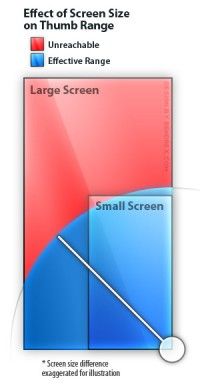
I’ve been using the iPhone for 3 generations. Right now I’m testing a Galaxy Nexus. If they made the same exact phone in a size that’s actually comfortable for one-hand use, I might call myself an Android convert. Curse you 4″+ screens and the awful fad that you are!
For me, the 4.65″ screen on the Galaxy Nexus is just too big. I constantly have to shuffle the phone around in my hand because Android places the two most frequently used aspects of the interface (the menu buttons and the notification drawer) at opposite ends of the phone. The size of the phone and the required shuffling means that I’ve got a poor grip on it, and I’ve been rather worried about dropping it during use. Again, those with larger hands will not have the same issue at 4.65″, but at some point they will run into the same problem.
Android Handset Screen Size Over Time
To show the trends of Android smartphone screen sizes over time, I compiled screen size and release date data from 155 smartphones from five major manufacturers (Motorola, Samsung, HTC, Sony, LG). I’d like to thank PDADB.net for their comprehensive release date info. (click to enlarge graphs)
As you can see, since the introduction of the 3.2″ HTC Dream / G1, screen sizes have consistently increased. Today we’re seeing 4″, 4.5″, 4.7″, 5″, and even 5.3″ smartphones! A simple projection (seen on the main chart) suggests that before 2013 is out, many handsets will have 5″ screens, while the flagship phones of that time may have even larger screens (if this trend continues) of 5.5″ or perhaps 6″.
With a slope of 0.0016, LG is increasing its Android smartphone screen sizes the most rapidly of these five manufactures. Despite pioneering some of the largest phones on the market at certain points in the timeline, Motorola is actually showing the slowest rate of increase in Android smartphone screen size with a slope of 0.0009, but of course this isn’t very far off from the leader!
Why is This Happening?
A good question to ask is what’s prompting the growth in screen size. It seems natural for manufacturers to have experimented with screen sizes as the platform grew legs. Different screen sizes are a point of differentiation for an Android phone manufacturer — a way to stand out in a sea of similar options. Bigger screens were also an easy way for companies to try to beat out the iPhone on features, even if the ‘bigger is better’ argument doesn’t hold much water in this case. Now it seems to have turned into a snowball effect whereby manufacturers are trying to one-up each other to have the biggest screen in town (all the while, Apple has stuck with 3.5″ since the introduction of their handsets). You wouldn’t believe how many times I’ve heard the phrase “biggest and baddest” when marketers are referring to a new Android phone. They use this phrase as though bigger is always better, but I must say — when it comes to comfortable one-handed smartphone use — it is not.
Where Does It Stop?
My question is this: where do we draw the line? As I mentioned, despite variations in hand sizes, everyone reaches a limit of comfortable one-hand usability at some point. I don’t have the raw data to back it up, but I believe that Android smartphone screen sizes are rapidly surpassing the maximum size for comfortable one-handed use by the average Android customer. None of this is to say there aren’t advantages to having a larger screen (particularly when it comes to media viewing), but given that people much more frequently use their smartphones for apps rather than media viewing, the argument for surpassing a users one-handed comfort zone to provide a better media experience is a poor one.
It’s not so much that screen-sizes are increasing (the chart clearly shows that other sizes are still available), but the bothersome fact is that it’s near-impossible to get a flagship phone unless you’re willing to buy one of the massive phones on the market. If you want a phone that comes in a size that’s comfortable for one-handed use, you have to be willing to settle as a second-class Android citizen — the only options available to you will likely have slower processors, less RAM (and may be based on an older platform) than the newest and biggest flagship phone currently on the market.

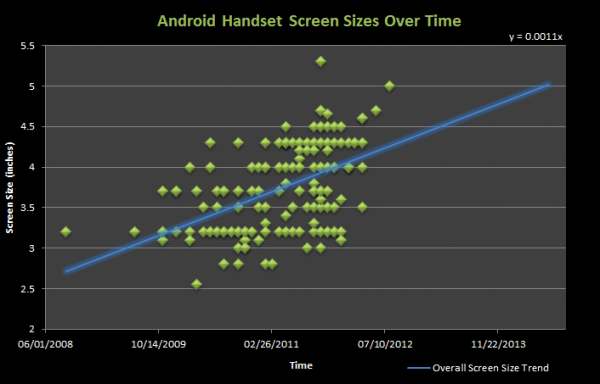
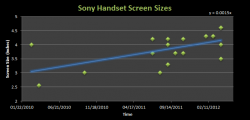
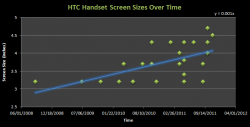
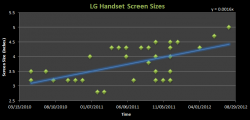
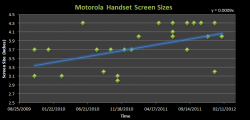
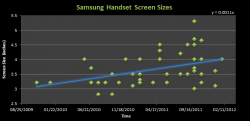










Your main argument is based on the fact that you use your phone with one hand and so the reach of your thumb should be the limit for the screen size. I think this is a very antiquated way to view mobile phones. Get with the times…. we have two thumbs you know :)
Ten years ago yeah probably 95% of us used one hand to tap out text messages on a keypad (not me though I hasten to add :) ); but nowadays we use qwerty keyboards on our phones
True, Jones, as I mentioned, I think if we’re to call it a ‘smartphone’ it’s gotta be one-hand usable. Beyond that, it’s a tablet.
Why set this criteria? Because smartphones are more of ‘on-the-go’ devices than tablets. The ability to be walking down the street and using your phone comfortably with one hand while having the other free to carry something (a bag? coffee?) is a defining feature of a smartphone in my mind.
Also, while I don’t have the expertise to make this claim outright, I do believe that it is more distracting to use your phone with both hands rather than one. They say the right-brain controls your left arm and your left-brain controls the right arm — perhaps using both hands to consciously control a device requires more brain activity than using it with just one hand. Being more distracted makes it harder to navigate your way around various obstacles that you might see while walking around. Again this is just a theory. Perhaps one day I’ll find an answer to it.
Carnies.. Circus folk.. Small hands..
*shivers*
So how small are your hands? Seriously. I’m using a t-mobile gs2 right now with a 4.52 inch screen and it is absolutely wonderful. I can easily use one hand for everything but typing and even that is possible, albeit not the easiest thing ever.
I say 4.5-5 inch should be the Max, because they are fantastic, but I also do think 4 inch phones should be getting more love. That’s the sweet spot, 4 inch phones can fit into the iPhone footprint with a small enough bezel; just look at the atrix!
4″ is probably the limit for me. Of course as I mentioned, everyone’s limit is different to some extent, but not being able to get the most powerful phone in a size that’s comfortable is a real same, and currently one of the things keeping me from getting an Android phone!
I don’t agree that the norm will be 5″. People’s hands are not getting larger so there is no sense doing a projection in this regard. I do think that manufacturers will be putting out phones with big screen to address those consumers who want or expect a big screen. However, you can be sure that this will not be true for all phones. I do think that a 4″ or 4.3″ screen would be the average.
An offset of this is that tablet sales would probably go down a bit, as consumers would prefer to buy a big-screen phone instead of a full-sized tablet because it is more mobile and useful. The attractiveness of a tablet, after all, is just a bigger screen to work with. The success of the Samsung Galaxy Note proves that this type of ‘tweener phone is feasible for manufacturers to follow.
I recently switched from the 4.0in G2x to the 4.52in Galaxy S II, and I must say the difference in screen size was a shock at first, but I hold my phone differently now, and my thumb can easily reach every corner of the device.
One of the diagrams shows the thumb range starting from the bottom right corner. Who holds their phone with the base of their thumb at the base of the device? The bottom right corner of my phone sits in the very center of my palm, and my thumb can reach just about the whole screen without having to adjust the position of the phone in my hand. That puts the base of my thumb pretty close to the dead center of the screen.
My wife’s Samsung Vibrant, with its 4in screen feels super tiny now. Too tiny. I could never go back to something under 4.5in, but I think I would have a hard time with anything over 4.5.
Take a math class, and maybe you won’t make dumb projections like this.
Yeah… even if it were logical to assume a linear growth the correlation doesn’t even appear to be .5.
Also, the trendline isn’t even correct the corner of the first plot states y=.0011x and the line appears to be y= .5x + 2008.
By that logic in 2056 we would have 2 foot screens
Hey Andrew and Jesse, thanks for pointing this out. First, I’m not excellent with statistics or Excel. That being said, I think Excel got a bit confused about how I was associating numbers with dates and it spat out some interesting y values. I included the y values on the charts for relative comparison between them only. The y values were also direct from Excel itself, not entered by me, so I’m not sure what might have caused it to be incorrect if that’s the case.
As for the projection, I understand it’s quite basic as it’s linear and the goal here was not to be super scientific or precise but rather just to demonstrate a trend that I’ve noticed and written about prior, but until this point didn’t have hard data to point to. Even without the trend lines, you can still see where the size is heading.
Andrew, if I provided you with the data, would you be so kind as to do a more advanced trend line?
I see your point (sort of), but honestly, who holds their phone by the bottom left corner? I don’t think I could hold it that way if I tried. Your example drawing would work better if you moved the thumb up at least a third of the way up the phone. Regardless, I have a GNex, and I could comfortably use a phone that was about 10% bigger. Beyond that I think we’re getting into tablet realm.
Well, if you hold your phone and try to pivot your thumb (without flexing your palm) you’ll find that the thumb doesn’t go much lower than horizontal with the ground. Yes, you can get some extra mobility by flexing the palm, but as the size of the screen increases, so does the width of the phone — this reduces the ability of your palm to bend and achieve that extra mobility, not to mention that the screen becomes significantly longer than the thumb and thus reaching the entire screen requires shuffling the phone in your hand.
Shuffling is the part that is bad because it means you don’t have a good grip on the phone and you’re likely to drop it. At certain sizes you can get away without shuffling, but it will require bothersome straining of you hand to reach all the way up to the notification drawer and back down. Beyond a certain screen size, stretching and straining won’t even cut it and you’ll have to start shuffling the phone around in your hand.
I want to point out that direct comparison to the idevice realm is a little misleading for a couple of other reasons
1) the aspect ratios are different so not all 4 inch screens have the same surface area or require the same thumb stretching…
2) I appreciate your point about not moving the thumb much below the horizontal. one key difference here is that with the new software design of Android 4.0 the onscreen keys make more of the phones front surface into usable space, accomplishing what Jobs always wanted to do and getting rid of the buttons on the bottom. with this in mind, an Android device running 4.0 with a 4 inch screen, actually requires LESS thumb reaching than an iDevice held in an identical manner.
Thanks for this article…
cf
There is only one dimensional consideration that I would consider for a smartphone. Can it be held up to your ear with one hand to listen to the phone speaker.
Beyond that you make assumptions that I don’t agree with. Why is it necessary for a smartphone to be operated with one hand? The only reason you couldn’t use your second hand is if you are doing something with the other. If that means you are driving or something then you shouldn’t be doing that anyway.
I use a Gnex, I find that anything simple I can easily do with one hand. If I need to do something more complex I have no problem pausing for a second to use the second hand to type. Let us not forget Androids great voice to text input, which makes typing a half necessity imo.
Personally I found Steve Jobs blanket statements against larger phones, and “if a phone has a stylus, then the manufacturers “blew it” to be the worst moves that they could have made, of course they will white wash over it if pens make a comeback, as I think they might.
For me there are a few things to think about in a “smart phone”
One is that it must be suitable for making phone calls. This should be a standard part of the phone and should actual have a call button as standard. I disagree with these being got rid of. It actuall y simplifies life to have a separate key and is quicker. The same is true if you want to use it as a camera.
Other than this it should have as large a screen as possible. You can use Ben’s criteria of where he can reach with one thumb – though actually this isn’t a hardware issue, but a software issue.
I never hold my phone at the bottom – most uncomfortable, should have a proper grippable back for holding at the side – also can easily reach further then.
The limit is actually weight and size for comfortable holding and carrying in your jeans pocket. If you need a jacket / purse then you are into tablet territory (unless of course your jeans don’t have pockets!)
You can get up to a 5.6″ screen in a phone slightly bigger than a note with a small bezel and a nicely rounded back which will go into my pocket as easily as a 4″ phone. I know because I made a mockup once.
It does mean that sometimes you have to use two hands or two thumbs, but people who were brought up txtng or with BBs do this without thinking. When you have a decent res. like 1280 x 800 then you have a great design.
Personal I would like to have a phone with slider and then it becomes a complete carrypad!
You’re completely forgetting one if the major selling points of the iphone when it first came out, multitouch and pinch to zoom. Try doing that one handed.
It was clear to me that when ii switched from my Treo to an HTC Hero with a 3.5 inch screen that i was giving up a lot of one handed use.
Just because your co-worker agrees doesn’t make it so : P
If you look at the font size on an iPhone vs. a Galaxy Nexus, it’s almost distinguishable. A 1″ difference in screen size is not going to have any significant impact on eye-strain (and strain is far different than ‘damage’). This is like saying a 26″ TV is going to hurt your eyes while a 32″ will be perfectly fine.
As for hardware quality… the iPhone 4/4S is one of the most solid phones around, built with premium materials. No Android phone that I’ve used has come close, except for a few from HTC (Nokia might also match Apple’s build quality if they made Android devices!). I’ve got the Galaxy Nexus right here with me, and while it’s definitely a step up from the Nexus S, it’s no iPhone. The LG Spectrum, which I’ve also got here, feels like a slab of plastic compared to the iPhone 4.